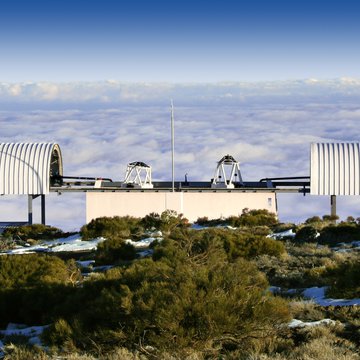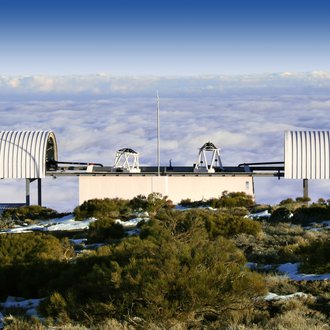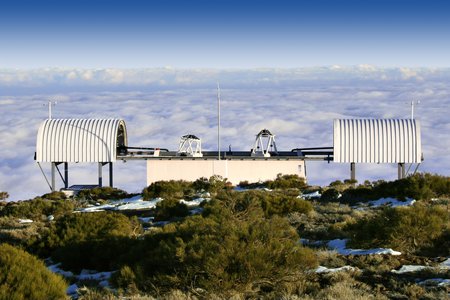Celebrating Ten Years of Science with STELLA
Since 2006, the two robotic STELLA telescopes of the Leibniz Institute for Astrophysics Potsdam (AIP) are observing the night sky at the Observatorio del Teide, Tenerife. STELLA is an acronym for STELLar Activity. In a workshop at AIP, scientists now look back on a decade of exciting astronomical observations.
Over the past ten years STELLA has proved to be an excellent tool to accomplish thrilling scientific results. Since the telescopes were explicitly designed for long-term observation of individual objects, especially magnetically active stars, STELLA achieves this goal more easily than a lot of other telescopes. The robotic telescopes at Tenerife already observed complete magnetic activity cycles of distant stars and determined for the first time the decay time of star spots. On top of that, STELLA proved that there is rarely an exception to the principle that as stars age their rotation periods decrease, and vice versa proving that by knowing the rotation period of a star scientists can determine its age.
Operating a fully autonomous, robotic observatory is uncommon both in Germany and internationally. Replacing an onsite observer and their decision-making with a piece of software is a true challenge. STELLA has a meteorological station that constantly measures temperature, humidity, precipitation, and wind speed. A separate camera detects clouds obscuring the night sky. At dusk, an algorithm decides if conditions are safe for opening and commencing observations. All control duties, from positioning and focussing of the telescopes to the fineguiding system, are managed by the software.
Observatorio del Teide
The Observatorio del Teide has an international reputation in solar and stellar research. Lying in the middle of the Atlantic ocean on top of a volcanic mountain range, the astronomical observing conditions are close to optimal. In addition to STELLA, the AIP is also involved in the operation of the GREGOR solar telescope, Europe’s largest solar telescope, and the Vacuum Tower Telescope, both located on Tenerife.
Further information
Press Release “First movie of stellar-surface evolution beyond our Solar System” (20.10.2015)
Additional pictures, please credit: Leibniz Institute for Astrophysics Potsdam (AIP)
Science contact: Dr. Thomas Granzer, +49 331-7499 350, tgranzer@aip.de
Media contact: Kerstin Mork, +49 331-7499 803, presse@aip.de
Since 2006, the two robotic STELLA telescopes of the Leibniz Institute for Astrophysics Potsdam (AIP) are observing the night sky at the Observatorio del Teide, Tenerife. STELLA is an acronym for STELLar Activity. In a workshop at AIP, scientists now look back on a decade of exciting astronomical observations.
Over the past ten years STELLA has proved to be an excellent tool to accomplish thrilling scientific results. Since the telescopes were explicitly designed for long-term observation of individual objects, especially magnetically active stars, STELLA achieves this goal more easily than a lot of other telescopes. The robotic telescopes at Tenerife already observed complete magnetic activity cycles of distant stars and determined for the first time the decay time of star spots. On top of that, STELLA proved that there is rarely an exception to the principle that as stars age their rotation periods decrease, and vice versa proving that by knowing the rotation period of a star scientists can determine its age.
Operating a fully autonomous, robotic observatory is uncommon both in Germany and internationally. Replacing an onsite observer and their decision-making with a piece of software is a true challenge. STELLA has a meteorological station that constantly measures temperature, humidity, precipitation, and wind speed. A separate camera detects clouds obscuring the night sky. At dusk, an algorithm decides if conditions are safe for opening and commencing observations. All control duties, from positioning and focussing of the telescopes to the fineguiding system, are managed by the software.
Observatorio del Teide
The Observatorio del Teide has an international reputation in solar and stellar research. Lying in the middle of the Atlantic ocean on top of a volcanic mountain range, the astronomical observing conditions are close to optimal. In addition to STELLA, the AIP is also involved in the operation of the GREGOR solar telescope, Europe’s largest solar telescope, and the Vacuum Tower Telescope, both located on Tenerife.
Further information
Press Release “First movie of stellar-surface evolution beyond our Solar System” (20.10.2015)
Additional pictures, please credit: Leibniz Institute for Astrophysics Potsdam (AIP)
Science contact: Dr. Thomas Granzer, +49 331-7499 350, tgranzer@aip.de
Media contact: Kerstin Mork, +49 331-7499 803, presse@aip.de
Images
STELLA at Tenerife.
Big screen size [1000 x 666, 130 KB]
Original size [2586 x 1724, 630 KB]





